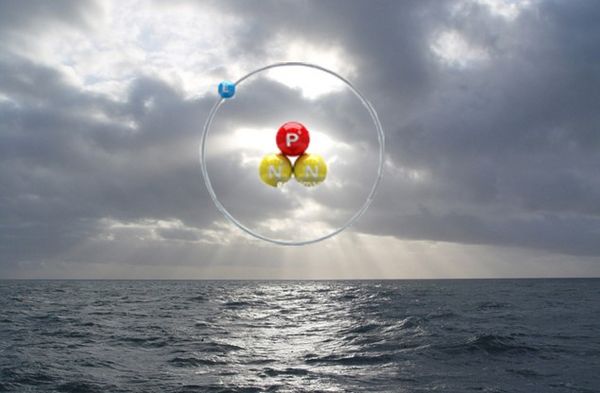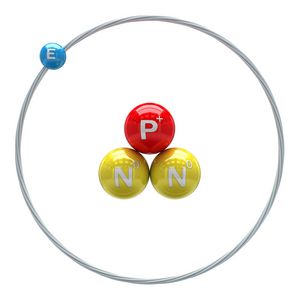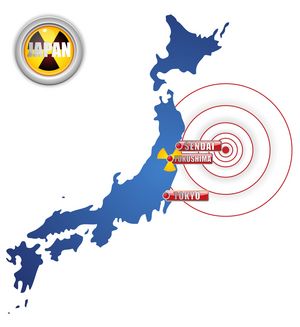FAQ
Assessing the impacts of the tritium discharges into the Pacific Ocean
Marc-Oliver Aust | 22.08.2023

The operator of the nuclear power plant in Fukushima damaged in March 2011, has been discharging water containing radioactive tritium into the Pacific Ocean since August 2023. The following text provides an assessment of possible impacts on the marine environment.
The Japanese corporation Tepco, operator of the Fukushima Daiichi nuclear power plant, which was damaged in March 2011, has started to discharge water containing the radioactive hydrogen isotope tritium into the Pacific on 24 August 2023. A permit for the discharge has been granted on 10 May 2023. The International Atomic Energy Agency (IAEA) found the discharge to be safe on 4 July 2023.
What quantities are involved, do these affect the marine environment and is there a health risk for humans as consumers of fish? The following text provides information and assesses the risk on these discharges.

Tritium is an isotope of hydrogen that naturally occurs in traces. In contrast to "normal" hydrogen, whose atomic nucleus has only one proton, the tritium nucleus consists of one proton and two neutrons. Tritium is therefore also called "superheavy" hydrogen. Tritium is constantly formed naturally in the upper atmosphere. About 99 % of it is bound in water.
Tritium is also formed as a by-product of nuclear fission in boiling water reactors, such as those used in the Fukushima Daiichi nuclear power plant.
Tritium is a radioactive substance that emits beta radiation (electrons) of low energy; it decays with a half-life of 12.3 years to stable, i.e. non-radioactive helium-3. It has a very low dose coefficient, and therefore be used in so-called consumer products (e.g. luminous numerals in watches, luminous fishing lures). The dose coefficient is a measure of the effect of a radioactive isotope on the body of a person has who ingested the substance. It is expressed in Sv/Bq (Sievert per Becquerel). At 1.8*10-11 Sv/Bq, the dose coefficient of tritium is about a thousand times lower than that of radioactive caesium, which was also released during the reactor disaster in Fukushima and entered the sea.
The contaminated water accumulates on the one hand during the cooling of the destroyed reactor cores, and on the other hand through uncontrolled groundwater inflow to the reactor buildings. The cause of the accident at the nuclear power plant was a seaquake off the east coast of Japan in March 2011. As a result of which a devastating tsunami hit the coast, flooding the power plant and causing the cooling system of the nuclear power plant to fail, leading to explosions and core meltdowns in several reactor units.
The water contains various radionuclides in different concentrations. Technical measures were able to significantly reduce the inflow of water from the environment, but not to stop it completely. To prevent the contaminated water from being uncontrollably discharged into the Pacific Ocean, it is pumped out of the facility and treated with an advanced system for removing radionuclides dissolved in liquids (Advanced Liquid Processing System, ALPS). However, since the tritium is incorporated into the water molecules, it cannot be removed from the water using ALPS, like radionuclides dissolved in water such as caesium isotopes. For this reason, about 1.34 million tonnes of water containing tritium are currently stored in tanks on the reactor site (for reference: in terms of volume, this corresponds to about one tenth of the annual drinking water consumption of a medium-sized German city like Braunschweig).
The storage capacity on the nuclear power plant site is almost exhausted by now. The number of tanks is only one of the reasons für this. In order to reduce the risk of further contamination of the environment, it is necessary to dismantle the damaged nuclear power plant, for which space is also needed. In addition, there is the problem that the existing tanks for contaminated water are not permanent and must be regularly checked or replaced. For this reason, it is essential to plan how to deal with the contaminated water.
Five approaches have been developed and discussed for the long-term handling of the contaminated water: Injection underground, controlled release into the sea, controlled evaporation, hydrogen release and solidification with underground disposal. After intensive assesment, discharge into the sea has proven to be the most practicable option in terms of minimising possible risks, technical feasibility and temporal integration into the dismantling measures of the reactors. Risks to the marine environment are considered to be low, since
- the waste water in which the radionuclide concentrations exceeding legal limits will be further purified using ALPS system so that, with the exception of tritium, the concentrations will subsequently fall below the limits,
- the tritium concentration in the discharged water is reduced to 1500 Bq L-1 by dilution,
- the tritium inventory discharged annually is limited to 22 TBq. This corresponds to the value that was already permitted before the accident at the Fukushima nuclear power plant.
The International Atomic Energy Agency has reviewed the report of the ALPS Committee (SHALPS, 2020) and agrees with its opinion, but also provides additional justifications and clarifications for the discharge of contaminated water into the Pacific Ocean (IAEA, 2020, 2022, 2023). In particular, a communication strategy is to be developed and the exchange with stakeholders and associations has to be intensified. The discharge of the 1.34 million tonnes of contaminated water is to take place successively within the next 30 years.
Tritium is incorporated into organic material because it behaves like normal hydrogen. In the human body – and very likely also in animals – tritium is quickly excreted (half-life of approx. 10 days). Therefore, the health risk posed by tritium to humans and animals is considered low in the literature (Galeriu & Melintescu, 2010; Povinec et al., 2017). However, it is not yet scientifically certain whether the risk from defects to the genetic material that can arise after incorporation of tritium into DNA has been underestimated so far (European Commission, 2008; HPA, 2007).
According to the International Atomic Energy Agency (IAEA 2004), tritium is not enriched in fish, i.e. the concentrations in fish and water are identical. In contrast to tritium, the radionuclide caesium is enriched one hundred times in fish compared to the concentration in water. While tritium is relatively difficult to detect in fish and it is also difficult to distinguish anthropogenic discharges from the natural background, the concentration of tritium in water is comparatively easy to determine. Unlike in fish an almost arbitrarily large quantity of water can be analysed for its tritium activity concentration throuh enrichment. The enrichment increases the tritium activity concentration in the subsequent measurement preparation in such a way that the measuring device also produces a valid measurement value or the natural background contained in the sample can be "masked out".
Previous discharges of tritium from the damaged Fukushima nuclear power plant into the Pacific Ocean were readily detectable in water in a distance of 40 km from the nuclear power plant in June 2011, although the amounts discharged were significantly less than those of previous or current events/activities, such as the nuclear weapons fallout or discharges from nuclear fuel reprocessing facilities (Povinec et al., 2017). As with the caesium released into the sea in the course of the accident, the amount of tritium in the water body of the Pacific will be highly diluted.
In the affected areas, monitoring of the marine environment, especially of tritium, is to be further intensified. The operating company TEPCO is responsible for investigations on the site of the plant, the state regulatory authority NRA (National Regulation Authority) is responsible for the areas of water and sediment, and the Japanese Fisheries Agency is responsible for marine organisms.
TEPCO will present all experiments and measured data obtained during the tritium discharge from the following website: https://www.tepco.co.jp/en/decommission/progress/watertreatment/index-e.html.
The monitoring results by the NRA and the Fisheries Agency are published, sorted by topics, on the following websites: https://radioactivity.nra.go.jp/en/ and https://www.jfa.maff.go.jp/e/inspection/index.html.
In order to record the effect of the discharges on the marine environment and to be able to compare them with the estimations, it is planned to release only small amounts of tritium-containing water into the Pacific in an initial phase. Only when it is confirmed that there will be little or no impact on the marine environment, the discharge of tritium-containing water will be continued.
Summary and assessment
Tritium is a radionuclide that is formed naturally in large quantities and a significant proportion of which is bound in water. The discharges from the tanks of the damaged Fukushima nuclear power plant will fall below the authorised discharges for the operation of the intact Fukushima nuclear power plant. This makes them very small compared to the amount of naturally occurring tritium. Tritium, if absorbed by marine organisms, is also rapidly excreted.
Under the boundary conditions mentioned above, it is very unlikely that direct or indirect radiation effects will be detectable in marine organisms. A risk to the consumer is also estimated to be very low from a radiation protection perspective.
European Commission (2008): Emerging Issues on Tritium and Low Energy Beta Emitters. Radiation Protection No. 152, Proceedings of the EU Scientific Seminar 2007. 108 p.
Health Protection Agency (2007): Review on risks from Tritium, „Report of the independent Advisory Group on Ionising Radiation“, Documents of the Health Protection Agency, Radiation, Chemical and Environmental Hazards (November 2007), 104 p.
International Atomic Energy Agency (2004): Sediment distribution coefficients and concentration factors for biota in the marine environment. Technical Report Series No. 422, Vienna, 103 p. Online: http://www-pub.iaea.org/books/IAEABooks/6855/Sediment-Distribution-Coefficients-and-Concentration-Factors-for-Biota-in-the-Marine-Environment; zuletzt abgerufen: 28.11.2022
IAEA (2020): IAEA Follow-up Review of Progress Made on Management of ALPS Treated Water and the Report of the Subcommittee on Handling of ALPS treated water at TEPCO’s Fukushima Daiichi Nuclear Power Station. Online: https://www.iaea.org/sites/default/files/20/04/review-report-020420.pdf; zuletzt abgerufen: 28.11.2022
IAEA (2022): IAEA Review of Safety Related Aspects of Handling ALPS-Treated Water at TEPCO’s Fukushima Daiichi Nuclear Power Station - Report 1: Review Mission to TEPCO and METI (February 2022). Online: https://www.iaea.org/sites/default/files/report_1_review_mission_to_tepco_and_meti.pdf; zuletzt abgerufen: 03.01.2023
IAEA (2023): IAEA comprehensive report on the safety review of the ALPS-treated water at the Fukushima Daiichi nuclear power station. Online: https://www.iaea.org/sites/default/files/iaea_comprehensive_alps_report.pdf; zuletzt abgerufen: 05.07.2023
Galeriu D. und Melintescu A. (2010): Tritium. In: Atwood D.A., Radionuclides in the Environment, p. 47-63
Povinec P.P., Kwong L. W., Kaizer J., Molnár M., Nies H., Palcsu L., Papp L., Pham M.K. and Jean-Baptist P. (2017): Impact of the Fukushima accident on tritium, radiocarbon and radiocesium levels in seawater of the western North Pacific Ocean: A comparison with pre-Fukushima situation.
The Inter-Ministerial Council for Contaminated Water, Treated Water and Decommissioning issues (ICCW, 2021): Basic Policy on handling of ALPS treated water at the Tokyo Electric Power Company Holdings’ Fukushima Daiichi Nuclear Power Station. Online: https://www.meti.go.jp/english/earthquake/nuclear/decommissioning/pdf/bp_alps.pdf; zuletzt abgerufen: 28.11.2022
The Subcommittee on Handling of the ALPS Treated Water (SHALPS, 2020): The Subcommittee on Handling of the ALPS Treated Water – Report. Online: https://www.meti.go.jp/english/earthquake/nuclear/decommissioning/pdf/20200210_alps.pdf; zuletzt abgerufen: 28.11.2022


![[Translate to English:] Logo des Bundesministerium für Ernährung und Landwirtschaft](/media/allgemein/logos/BMEL_Logo.svg)